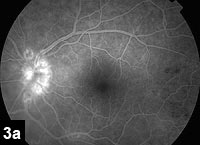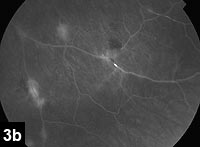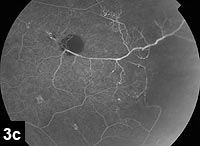Woman presents with visual disturbance in left eye
Examinations showed optic neuropathy, vitritis and areas of vasculitis.

 Jeffrey Chang |  Vivek Chaturvedi | ||
A healthy 51-year-old white woman was referred to the retina service at the New England Eye Center complaining of a line in front of her vision in the left eye for approximately 1 month. The visual disturbance was constant and associated with new floaters. The patient denied eye pain, photopsias or headaches. There were no alleviating or exacerbating factors, and she denied similar prior events. She did not note any changes in vision in her right eye.
The patient had no significant ocular or medical history. She had a rash in the past associated with penicillins and was on Zyrtec (cetirizine, Pfizer) for seasonal allergies. Social history was significant for a 15 pack-year smoking history.
 Right and left color fundus photographs. In the left fundus, there is moderate vitritis, optic disc edema with peripapillary cotton wool spots, retinal edema inferotemporally along the vascular arcade with hard exudates and focal retinal hemorrhage temporal to the macula. Right and left color fundus photographs. In the left fundus, there is moderate vitritis, optic disc edema with peripapillary cotton wool spots, retinal edema inferotemporally along the vascular arcade with hard exudates and focal retinal hemorrhage temporal to the macula. |
 Left color peripheral fundus photographs showing focal vasculitis along retinal veins. Left color peripheral fundus photographs showing focal vasculitis along retinal veins.
Images: Chang J, Duker JS |
Examination
On examination, the patient’s best corrected visual acuity was 20/20 in the right eye and 20/25 in the left eye. Pupillary light reaction was symmetric with no afferent pupillary defect. Extraocular motility and confrontation visual fields were full in both eyes. Applanation tonometry was 12 mm Hg bilaterally. External and anterior segment exams were unremarkable.
The right dilated fundus exam was unremarkable. Examination of the left fundus demonstrated moderate anterior vitreous cell, optic disc edema and focal retinal hemorrhage temporal to the macula (Figure 1). Peripherally, areas of phlebitis were noted inferiorly and temporally in the left eye (Figure 2).
Fluorescein angiogram showed optic disc hyperfluorescence in the left eye along with focal areas of vasculitis and peripheral retinal capillary non-perfusion (Figures 3a, 3b and 3c). There was no significant macular edema.

What is your diagnosis?
Vasculitis and vitritis
The differential diagnosis of vasculitis and vitritis with associated optic disc edema involves systemic infectious and inflammatory conditions. Infectious etiologies include Bartonella henselae, toxoplasmosis, syphilis, Lyme disease, and herpes zoster and simplex. Inflammatory conditions include sarcoidosis, Wegener’s granulomatosis, systemic lupus erythematosus, polyarteritis nodosum, Behçet’s disease and multiple sclerosis. Other less likely entities on the differential include leukemia, lymphoma and Eales’ disease.
 Fluorescein angiogram, left eye. Optic nerve head hyperfluorescence.  Fluorescein angiogram, left eye. Peripheral vasculitis.  Fluorescein angiogram, left eye. Peripheral retinal capillary non-perfusion. | ||
A systemic work-up was performed, including complete blood count, erythrocyte sedimentation rate, anti-nuclear antibody, anti-neutrophilic cytoplasmic antibodies, Bartonella antibodies, Lyme antibody titers and angiotension converting enzyme. A chest X-ray was also obtained. All blood work results were within the normal range. The chest X-ray showed diffuse reticular changes consistent with sarcoidosis, although angiotension converting enzyme was in the normal range. The negative blood work ruled out most infectious causes. The most common systemic inflammatory conditions accounting for the exam findings would be sarcoidosis or a collagen vascular disorder.
Based on the chest X-ray results, the patient was given a presumptive diagnosis of ocular sarcoidosis with uveitis, vasculitis and optic neuropathy and referred to her primary care physician for further sarcoidosis work-up. Because of the low likelihood of an infectious etiology, the patient was given a Medrol dose pack (methylprednisolone, Pfizer) and then a sub-Tenon’s injection of Kenalog (triamcinolone acetonide, Bristol-Myers Squibb) to treat the vitritis and vasculitis. The patient responded well, and eventually the optic disc edema, vasculitis and areas of hemorrhage cleared.
Discussion
Sarcoidosis is a chronic granulomatous disease affecting the entire body and most typically involving an anterior granulomatous uveitis. In one report, 7% of chronic sarcoidosis patients had posterior segment involvement. Sanders and Shilling divide retinal sarcoidosis into four stages: focal periphlebitis, venous occlusion, acute retinopathy and late onset neovascularization. Although neovascularization of the retina or optic disc was not seen on exam, the patient should be followed closely to monitor for the development of neovascularization in light of the areas of peripheral non-perfusion. In one case series, retinal capillary non-perfusion was demonstrated in all eyes with retinal neovascularization.
Corticosteroids are used when active retinal vasculitis or vitritis is present. Panretinal photocoagulation has a role in reducing the neovascular drive in areas of non-perfusion, but there does not appear to be a role for prophylactic laser treatment.
For more information:
- Jeffrey Chang, MD, and Jay S. Duker, MD, can be reached at New England Eye Center, Tufts University School of Medicine, 750 Washington St., Box 450, Boston, MA 02111; 617-636-4219; fax: 617-636-4866; Web site: www.neec.com.
- Edited by Jeffrey Chang, MD, and Vivek Chaturvedi, MD. Drs. Chang and Chaturvedi can be reached at New England Eye Center, Tufts University School of Medicine, 750 Washington St., Box 450, Boston, MA 02111; 617-636-4219; fax: 617-636-4866; Web site: www.neec.com. Drs. Chang and Chaturvedi have no direct financial interest in the products mentioned in this article, nor are they paid consultants for any companies mentioned.
References:
- Duker JS, Brown GC, McNamara JA. Proliferative sarcoid retinopathy. Ophthalmology. 1988;95(12):1680-1686.
- Jampol LM, Goldbaum MH. Peripheral proliferative retinopathies. Surv Ophthalmol. 1980;25(1):1-14.
- Sanders MS, Shilling JS. Retinal, choroidal, and optic disc involvement in sarcoidosis. Trans Opthalmol Soc UK. 1976; 96(1):140-144.
